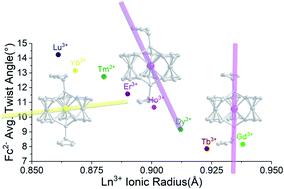当前位置:
X-MOL 学术
›
Chem. Sci.
›
论文详情
Our official English website, www.x-mol.net, welcomes your
feedback! (Note: you will need to create a separate account there.)
Trends in trigonal prismatic Ln-[1]ferrocenophane complexes and discovery of a Ho3+ single-molecule magnet
Chemical Science ( IF 7.6 ) Pub Date : 2020-03-24 , DOI: 10.1039/d0sc01197e Trevor P. Latendresse 1, 2, 3, 4 , Veacheslav Vieru 5, 6, 7, 8, 9 , Apoorva Upadhyay 1, 1, 2, 3, 4 , Nattamai S. Bhuvanesh 1, 2, 3, 4 , Liviu F. Chibotaru 5, 6, 7, 8 , Michael Nippe 1, 2, 3, 4
Chemical Science ( IF 7.6 ) Pub Date : 2020-03-24 , DOI: 10.1039/d0sc01197e Trevor P. Latendresse 1, 2, 3, 4 , Veacheslav Vieru 5, 6, 7, 8, 9 , Apoorva Upadhyay 1, 1, 2, 3, 4 , Nattamai S. Bhuvanesh 1, 2, 3, 4 , Liviu F. Chibotaru 5, 6, 7, 8 , Michael Nippe 1, 2, 3, 4
Affiliation

|
Lanthanide metallocenophanes are an intriguing class of organometallic complexes that feature rare six-coordinate trigonal prismatic coordination environments of 4f elements with close intramolecular proximity to transition metal ions. Herein, we present a systematic study of the structural and magnetic properties of the ferrocenophanes, [LnFc3(THF)2Li2]−, of the late trivalent lanthanide ions (Ln = Gd (1), Ho (2), Er (3), Tm (4), Yb (5), Lu (6)). One major structural trend within this class of complexes is the increasing diferrocenyl (Fc2−) average twist angle with decreasing ionic radius (rion) of the central Ln ion, resulting in the largest average Fc2− twist angles for the Lu3+ compound 6. Such high sensitivity of the twist angle to changes in rion is unique to the here presented ferrocenophane complexes and likely due to the large trigonal plane separation enforced by the ligand (>3.2 Å). This geometry also allows the non-Kramers ion Ho3+ to exhibit slow magnetic relaxation in the absence of applied dc fields, rendering compound 2 a rare example of a Ho-based single-molecule magnet (SMM) with barriers to magnetization reversal (U) of 110–131 cm−1. In contrast, compounds featuring Ln ions with prolate electron density (3–5) don't show slow magnetization dynamics under the same conditions. The observed trends in magnetic properties of 2–5 are supported by state-of-the-art ab initio calculations. Finally, the magneto-structural relationship of the trigonal prismatic Ho-[1]ferrocenophane motif was further investigated by axial ligand (THF in 2) exchange to yield [HoFc3(THF*)2Li2]− (2-THF*) and [HoFc3(py)2Li2]− (2-py) motifs. We find that larger average Fc2− twist angles (in 2-THF* and 2-py as compared to in 2) result in faster magnetic relaxation times at a given temperature.
中文翻译:

三角棱柱形Ln- [1]二茂铁硼烷络合物的发展趋势和Ho3 +单分子磁体的发现
镧系金属茂是一类有趣的有机金属络合物,其特征是4f元素具有稀有的六坐标三角棱柱配位环境,且分子内与过渡金属离子的亲合力非常接近。在这里,我们目前对晚期三价镧系离子(Ln = Gd(1),Ho(2),Er()的二茂铁金属[LnFc 3(THF)2 Li 2 ] -的结构和磁性进行系统研究。3),Tm(4),Yb(5),Lu(6))。这类配合物中的一种主要结构趋势是二铁茂铁基(Fc 2-)平均扭转角,中心Ln离子的离子半径(r ion)减小,导致Lu 3+化合物6的最大平均Fc 2-扭转角。扭转角对r离子变化的如此高的灵敏度是此处呈现的二茂铁碳烷络合物所特有的,并且可能是由于配体所强的大三角平面分离(> 3.2Å)所致。这种几何形状还使非克拉默斯离子Ho 3+在没有施加直流磁场的情况下表现出缓慢的磁弛豫,使化合物2成为难于磁化反转(U)的基于Ho的单分子磁体(SMM)的罕见例子。)110–131 cm -1。相反,具有Ln离子且电子密度为(3-5)的化合物在相同条件下不会表现出较慢的磁化动力学。最新的从头算计算支持所观察到的2–5的磁性能趋势。最后,通过轴向配位体(THF in 2)交换进一步研究了三角形棱柱形Ho- [1]二茂铁oph烷基序的磁结构关系,得到[HoFc 3(THF *)2 Li 2 ] -(2-THF *)和[HoFc 3(py)2 Li 2 ] -(2-py)图案。我们发现,较大的平均Fc 2-扭曲角(在2-THF *和2-py中,与在2中相比)导致在给定温度下更快的磁弛豫时间。
更新日期:2020-04-24
中文翻译:

三角棱柱形Ln- [1]二茂铁硼烷络合物的发展趋势和Ho3 +单分子磁体的发现
镧系金属茂是一类有趣的有机金属络合物,其特征是4f元素具有稀有的六坐标三角棱柱配位环境,且分子内与过渡金属离子的亲合力非常接近。在这里,我们目前对晚期三价镧系离子(Ln = Gd(1),Ho(2),Er()的二茂铁金属[LnFc 3(THF)2 Li 2 ] -的结构和磁性进行系统研究。3),Tm(4),Yb(5),Lu(6))。这类配合物中的一种主要结构趋势是二铁茂铁基(Fc 2-)平均扭转角,中心Ln离子的离子半径(r ion)减小,导致Lu 3+化合物6的最大平均Fc 2-扭转角。扭转角对r离子变化的如此高的灵敏度是此处呈现的二茂铁碳烷络合物所特有的,并且可能是由于配体所强的大三角平面分离(> 3.2Å)所致。这种几何形状还使非克拉默斯离子Ho 3+在没有施加直流磁场的情况下表现出缓慢的磁弛豫,使化合物2成为难于磁化反转(U)的基于Ho的单分子磁体(SMM)的罕见例子。)110–131 cm -1。相反,具有Ln离子且电子密度为(3-5)的化合物在相同条件下不会表现出较慢的磁化动力学。最新的从头算计算支持所观察到的2–5的磁性能趋势。最后,通过轴向配位体(THF in 2)交换进一步研究了三角形棱柱形Ho- [1]二茂铁oph烷基序的磁结构关系,得到[HoFc 3(THF *)2 Li 2 ] -(2-THF *)和[HoFc 3(py)2 Li 2 ] -(2-py)图案。我们发现,较大的平均Fc 2-扭曲角(在2-THF *和2-py中,与在2中相比)导致在给定温度下更快的磁弛豫时间。











































 京公网安备 11010802027423号
京公网安备 11010802027423号